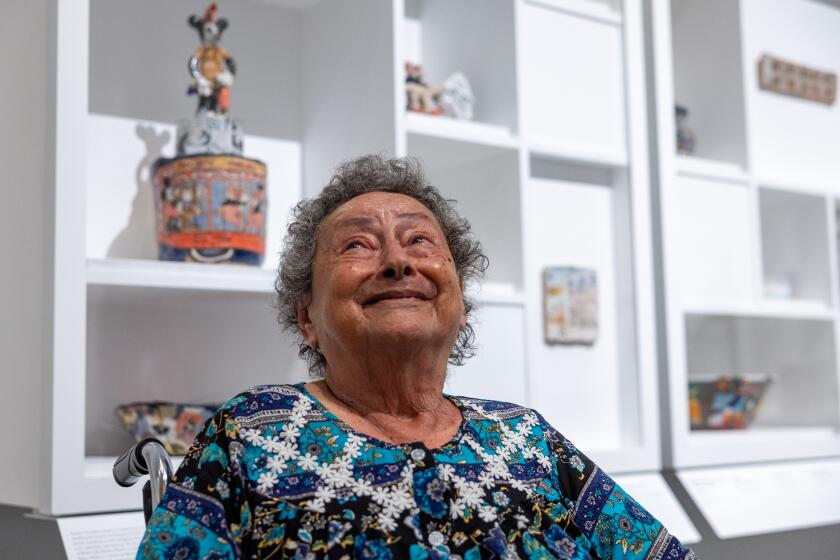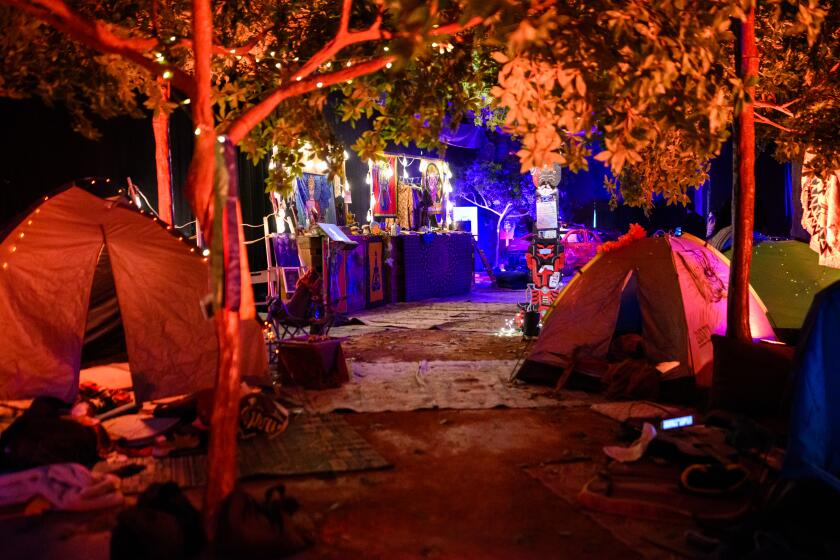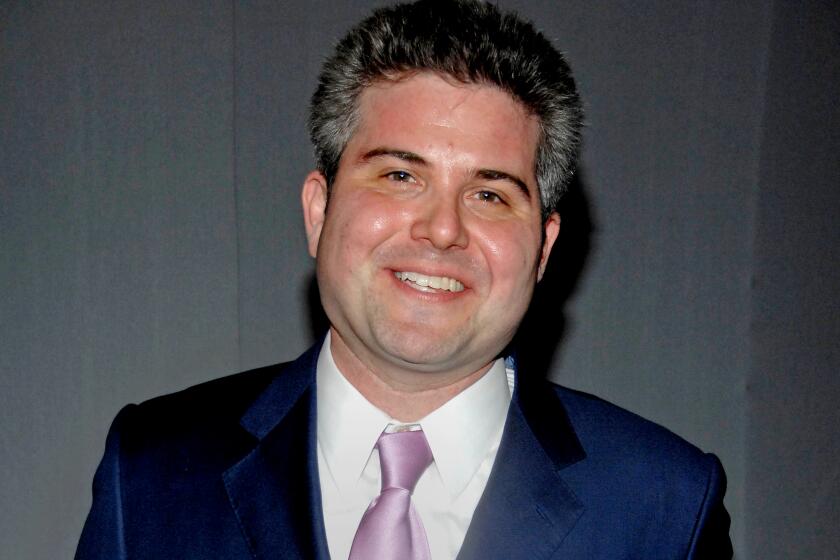The Lion’s Last Roar : Abstract Expressionist Sam Francis, his friends and associates say, was passionate, talented, generous and ferocious. In his last work, they see the genius and the pain of a man clinging to life.
The year preceding painter Sam Francis’ death last Nov. 4 at age 71 was a difficult one for him. Bedridden with a cancer that was detected in 1987, Francis saw his life as an artist change dramatically because of his illness.
A central figure in the second generation of Abstract Expressionists that emerged in the early 1950s, Francis took American abstraction into new territory by infusing his work with elements of Eastern philosophy, Jungian psychology and the glorious palette of Matisse. Francis was a gifted colorist who created a huge body of graphic work, much of which was created at the Litho Shop, a print shop he opened in 1970. He also published books and worked for philanthropic causes; he will perhaps be best remembered for his massive paintings combining ecstatic explosions of color with vast expanses of blazing white.
The artist was forced to scale down his ambitions in his final year, but nothing short of death could extinguish his need to paint--in the last five months of his life, he created 150 small paintings, using his signature bright palette and broad brushwork, that he intended to be hung floor to ceiling in one room and viewed as a single work. This final piece, titled simply “The Last Works,” went on view Thursday at the Los Angeles County Museum of Art.
Francis, a native of San Mateo, Calif., began his career as an artist in 1943 while hospitalized with spinal tuberculosis, which he contracted as a result of a plane crash. After earning a master’s degree in art from Berkeley in 1949, he moved to Paris in 1950, had his first solo show there the following year and maintained strong ties to Europe throughout his life. Francis returned to California in 1961, moving to Santa Monica to convalesce from a second bout of TB, and it was there he lived with his fifth wife, Margaret Smith Francis, at the time of his death.
In memory of this protean artist, friends and associates who were with Francis in his last year shared their thoughts on the artist and his final work in a series of recent interviews:
JACOB SAMUEL: Francis’ master printer , 1981 - 95
Prior to making these paintings, Sam hadn’t worked for six months because his right hand was crippled, and he’d always used both hands to paint. He felt uncomfortable trying to paint with just his left hand, but once he started he really got involved.
So we set up a large table and maybe 40 tubs of paint, prepared some paper and small canvases, and whoever happened to be around assisted him. He was in brutal agony while he was doing this because if he took enough medication to kill his pain he went to sleep--in order to work he had to be in pain. He knew this would be his last body of work, and he’d paint until he absolutely had no more energy--he would literally slump over and we’d take him back to bed. He even painted with an IV in his arm for a few days.
Ultimately, these paintings are about Sam’s incredibly strong will to create, and that’s something he had in abundance--he had such incredible passion and skill. I’ve worked with lots of artists, but nobody had what he had. He could walk into the studio with a blank mind and no plan whatsoever, armed only with the confidence to just start and see where it went.
Sam was frustrated by the turn his life had taken because he loved being outside, mountain biking and fishing, and being bedridden was unnatural for him. Nature continued to be important to him up to the end, and we used to take him down to the beach every day so he could watch the sunset. Music was also important to him during that last year. He listened to classical music, John Coltrane, Roy Orbison, and when he was really in pain the only thing he wanted to hear was Patsy Cline.
He had a few visitors, but he didn’t enjoy seeing people, because it was difficult for him to cope with the fact that he was no longer the lion but was the lion in winter. A powerful man like that has a powerful ego, and he had to come to terms with the fact that he couldn’t get out of his wheelchair and could never again work on anything large. He talked about having had enough of being in his body and wanting to let go of it. I remember wishing him a long life on his birthday in 1993, and he looked me in the eye and said: “It’s been long enough.”
DOUG SHIELDS: Painting assistant, 1985-95 Sam was never the same after he fell and broke his arm in 1992--he became consumed with his health at that point because he was petrified of dying.
Buddhism was no comfort to him as far as I could see. And he wasn’t ready to go, because he didn’t feel he’d completed his work as an artist. Two lifetimes wouldn’t have served him as an artist because he was a phenomenal worker and a most unusual human.
In the months prior to his death, his house took on a strange atmosphere--there were all sorts of people around making a last-ditch effort to save him. But he knew he was going down fast, and that the chaos of healers coming and going from the house couldn’t change that.Chaos, of course, was a big part of Sam’s life. He loved chaos, but I think it consumed him in the end.
The sheer brilliance of the man is there in a few of those last pieces, but many days he’d look at me and say, “I don’t know what I’m doing.” I’d tell him, “Yes, you do,” then he’d paint a bit, look up at me and say, “Well?”
In the end, it’s not a good body of work. There are a few gems in there, but essentially Sam is missing from them because his illness was fighting his creative abilities.
MARGARET FRANCIS: Francis’ wife Sam and I both felt he got cancer because he used to work wearing socks splattered with highly toxic paint--first he got arthritis, then he got cancer.
He ignored the diagnosis for a year because he didn’t want to accept that his cancer had recurred. He’d had cancer in the ‘70s and had gone on a juice fast that seemed to cure it, so when it recurred, he decided to try the program of nutrition and exercise that worked before. He got a mountain bike and moved to the mountains so he could get fresh air and went on a rigorous diet that revolved around eating deep-sea fish, which has a beneficial oil.
Sam’s health has always been fragile, but he’s always had an intense will and we both expected him to recover. An astrologer told us he was going to live a healthier life than he’d ever lived before, and that gave us a light at the end of the tunnel. He used to tell me, “Stop worrying--I’ll be here another 20 years because I want to see our son as a teen-ager.”
Last May a monk came and prayed over Sam, and at the end of his prayers the monk said, “The Divine requires more paintings from you”--and that’s when Sam started to paint again. He painted in a fury every day with a sense of divine mission.
SHINGO FRANCIS: Son of Francis and Mako Kawase In Zen, it’s important to cross the line past death. I would talk to Sam about these things, and he’d look at me as if I didn’t understand where he was at because he was in so much pain--emotionally he was completely preoccupied with the agony he was in.
As to whether he accepted his death, that’s hard to know because he was told he was going to recover. Several people around him believed he needed hope to recover, but I think it made him angry that people were being less than honest with him.
As to whether he wanted the alternative medicines he was given, I’d say it was more a case of him being subjected to them. In the last six months he often said, “I’m just an experiment and they do whatever they want to with me--I have no say in the matter.”
Early in the illness he had a treatment in Mexico, and over a period of three months he went from being a walking, independent person to someone confined to a wheelchair, unable to eat or speak very well. I disagreed with this treatment but soon discovered it wasn’t open to discussion.
The paintings were therapy that got his mind off his body, but they didn’t really challenge him, and I don’t think he’d want them shown. I’m sure he’d prefer people to look at work he made when he was able to work with his full ability. I wish they weren’t being exhibited, but I’m not interested in trying to control the situation.
MAUREEN GOSSETT: Francis’ nurse Sam was an unusual patient because he was undergoing so many treatments simultaneously. There were 30 different caregivers from all over the world attending him, and he loved the traffic of people through the house. He was open-minded, and everybody was special to him.
He liked to watch movies during that last year. He loved French movies and old black-and-white classics, and “The Sound of Music” was one of his favorites. I think he liked it because it was set in Switzerland and Austria, which is where he’d made a film about Carl Jung, and because it was a happy story about abundance and joy.
His son, Shingo, and I were with him the night he died. His Buddhist beliefs were a comfort to him, and I don’t think he was afraid, because although he wanted to live very badly, I think he was ready to make his transition. A few weeks before he stopped being able to speak, he told me, “I’m so discouraged,” and I realized then that he was no longer angry about being ill. He had submitted to his fate.
EBERHARD KORNFELD: Art dealer I met Sam in Paris in 1953 and we became close friends immediately. I was attracted to the integrity I saw in him, and I think he liked me as a good old Swiss character. So we got together a few times every year to admire his paintings, play around and talk about girls. Sam liked women--he married five of them and had maybe 100 others.
I did my first exhibition with Sam in 1956, and that early work was sensational, as was the midlife work; those vast white fields were highly original and were the next step after [Jackson] Pollock. I wouldn’t make too big a fuss about these final paintings, though, because they’re not of the quality we’re used to from Sam. Making them was important therapy for him, but this is the work of a seriously ill artist, and were he alive, I don’t think he’d allow them to be exhibited.
I saw him six months before he died, and we both knew what was about to happen. What do you say to a man who is so sick? He had the silly belief that these natural doctors could help him, and I tried to convince him a more serious treatment would be better, but he didn’t like that suggestion. I don’t know why he put his faith in alternative medicine, but then, Sam was a mystical person.
NANCY MOSHER: Francis’ personal curator, 1971-89 Knowing Sam made me understand how difficult it is to have the fate of an artist because I got to observe the intense struggle that exists when one is attempting to function as a normal human being while creating art that’s beyond life.
Sam didn’t want to be bound to the Earth, and painting enabled him to live that out--freedom and space play a big part in his painting, and Herman Melville’s book “Moby-Dick” was a big influence too. In the ‘50s, he made a series of paintings revolving around the idea of the whiteness of the whale--he was going after the great white of the canvas.
In the last year, he was like anybody going through a very important, somber and rich passage of life. It was hard to know what he was experiencing because Sam was private about his experience of dying, and you respected that. I think he approached death like any person, feeling angry and sad, but I think he was working it through on a deep, internal level. Sam always had to suffer the body during his life--it was really part of his fate, and hopefully he learned something from it.
DEBRA BURCHETT-LERE: Francis’ curator, 1992-95 Sam and I didn’t know each other that long, but from the minute we met it was as if we’d known each other all our lives--there was an immediate connection. We used to talk a lot about American Indians because I’m part Indian and he was fascinated by that, and we talked about old artists books from the years when he lived in Paris--I’d hunt for first editions for him. He was interested in many different things and could talk knowledgeably about everything from witchcraft to surfing.
I think that’s largely attributable to his upbringing--his parents were well-educated, and the letters Sam wrote them while he was living in Paris in the ‘50s are amazing--they’re intensely philosophical, poetic and esoteric. (The Sam Francis Foundation hopes to publish a volume of Francis’ letters next year.)
KRAUTH BRAND: Francis’ personal assistant, 1970-95 Sam was always very simple with me. My most vivid memory of him is of him riding his mountain bike in Point Reyes--he loved riding, and for as old as he was when he picked it up, what he did with it was pretty special.
Artists are notoriously selfish, but Sam could be generous. I’ve worked for lots of artists, and he was the first one to express an interest in my art. He always wanted to know what I was doing, and if I said I had something good going in my studio, he always said, “Go home.”
The last year of his life was pretty screwed, and he more or less stopped being the Sam I’d known because he was taken over by the pain he was in. I think he was afraid of dying and that he never really accepted death. I assisted him occasionally when he was making those last paintings, but I don’t know if he enjoyed working on them. Ultimately they’re about the fact that the door was closing on a great artist.
Sam could push paint better than anybody I’ve ever seen, and though his facility to paint was with him up to the end, he was on automatic a lot of the time. He was painting because he saw the end coming and was trying to get something out; however, those are not major works. People are sentimentalizing them for the obvious reason.
ED MOSES: L.A. Abstractionist When I met Sam in the ‘50s, my first impression of him was that he was a formidable man, aloof, formal and imposing. I never became comfortable with him, and although we became friends and shared warm moments, the friendship always went in and out of focus.
Sam could be generous and playful when we were alone, but when other people were around he had to maintain that he was the main man. He deferred to no one and everybody was in his service--Sam was the king.
I visited him last April, and he seemed happy to see me. We talked about his illness and watched a football game on television, then he drifted off. I felt sad after I saw him, despite the fact that even in his illness he was not vulnerable. He was physically vulnerable--a fact that irritated him--but mentally he was still powerful. Sam was powerful in the way one imagines Picasso was powerful--the way both those men assumed their position in the world as artists was very strong.
Who isn’t afraid of dying? Sam struggled with that fear, but he handled it beautifully and fought hard to stay alive. He was a great man; he believed he was a great man and wanted to keep contributing. He probably felt he was warming up to do his greatest paintings--which, of course, is what every artist thinks. I didn’t see any of his last paintings until after he died, and I think they’re magnificent, magical little creatures.
ANDRE EMMERICH: Francis’ dealer since 1971 When I visited Sam last summer, I knew it would be the last time I’d see him, so it was a painful visit--to see someone you care for suffering as he was is hard. We had lunch and talked of his work, but my more vivid memory of him will remain seeing him paint in his studio prior to his falling ill. Sam allowed very few people in his studio when he was working--few painters do--so that was a terrific experience.
GEORGE PAGE: Director, the Litho Shop Inc., 1973-95 It took me 10 years to become comfortable with Sam. He had a tendency to draw people in very easily, like a lobster trap, and once you were in he often became aloof and abusive. So I was leery of being drawn into the lobster pot.
I was always on edge with Sam and avoided any kind of intimate sharing for a long time. In the last years I was able to relax with him because he finally began to let down his guard. My most important memory of Sam was the mellowing I saw take place in him toward the end of his life. I never thought that would happen, and it was nice when it did.
There were days in that last year when he felt fairly good and other days when he was unable to even consider art because nothing had any meaning for him. He talked a lot about wanting to die, and I can see why he felt that way because his pain was so great. The paintings provided him with an escape from all the medical stuff, but it’s not a great body of work. Yes, they have energy, they show tremendous courage, and there’s a lot of Sam in them, but they’re certainly not a major statement. How could they be? The man was reduced to a wheelchair and one arm.
Sam had a spirit that comes through in his greatest works, and there’s just no denying it. He had tremendous force, originality and clarity, and I learned a lot about creativity from him. I learned that it’s not a precise, clear-cut thing, that it’s mysterious and comes and goes of its own accord. And that when it comes, you must make use of it because it will never come back again in the same form.
* “Sam Francis: The Last Works,” Los Angeles County Museum of Art, 5905 Wilshire Blvd. Tuesdays-Thursdays, 10 a.m.-5 p.m.; Fridays, 10 a.m.-9 p.m.; Saturdays-Sundays, 11 a.m.-6 p.m. Through Sept. 17. (213) 857-6000. Margaret Smith Francis lectures on her late husband’s life, Saturday, 2 p.m.
More to Read
The biggest entertainment stories
Get our big stories about Hollywood, film, television, music, arts, culture and more right in your inbox as soon as they publish.
You may occasionally receive promotional content from the Los Angeles Times.






